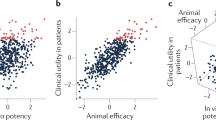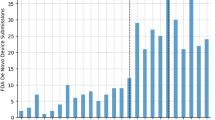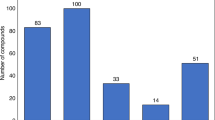Abstract
Strategic and legislative efforts to catalyse pharmaceutical innovation may be hampered by a lack of consensus over what characterizes an innovative drug. To help clarify this issue, we conducted an extensive survey on transformative drug development, involving ∼180 expert physicians based at 30 leading US academic medical centres, covering 15 medical specialties. In an iterative Delphi process, the survey participants narrowed a list of all new drugs approved in their fields in the past 25 years and reached consensus over those that they considered to be most transformative, which are presented in this article. Participants were also asked how various factors affected their opinion; they most often invoked the effectiveness and superiority of the drugs over existing alternatives when identifying transformative drug innovation.
This is a preview of subscription content, access via your institution
Access options
Subscribe to this journal
Receive 12 print issues and online access
$209.00 per year
only $17.42 per issue
Buy this article
- Purchase on Springer Link
- Instant access to full article PDF
Prices may be subject to local taxes which are calculated during checkout
Similar content being viewed by others
References
Munos, B. Lessons from 60 years of pharmaceutical innovation. Nature Rev. Drug Discov. 8, 959–968 (2009).
Karberg, S. Biotech's perfect storm. Cell 138, 413–415 (2009).
FitzGerald, G. A. Perestroika in pharma: evolution or revolution in drug development? Mt. Sinai J. Med. 77, 327–332 (2010).
Pammolli, F., Magazzini, L. & Riccaboni, M. The productivity crisis in pharmaceutical R&D. Nature Rev. Drug Discov. 10, 428–438 (2011).
US Food and Drug Administration (FDA). Driving biomedical innovation: initiatives to improve products for patients. FDA website [online] (2011).
Melese, T., Lin, S. M., Chang, J. L. & Cohen, N. H. Open innovation networks between academia and industry: an imperative for breakthrough therapies. Nature Med. 15, 502–507 (2009).
Munos, B. H. & Chin, W. W. How to revive breakthrough innovation in the pharmaceutical industry. Sci. Transl. Med. 3, 89cm16 (2011).
Kramer, D. B. & Kesselheim, A. S. Users fees and beyond — the Food and Drug Administration Safety and Innovation Act of 2012. N. Engl. J. Med. 367, 1277–1279 (2012).
Kesselheim, A. S. An empirical review of major legislation affecting drug development: past experiences, effects, and unintended consequences. Milbank Q. 89, 450–502 (2011).
Aronson, J. K., Ferner, R. E. & Hughes, D. A. Defining rewardable innovation in drug therapy. Nature Rev. Drug Discov. 11, 253–254 (2012).
[No authors listed.] New drugs and indications in 2010: inadequate assessment; patients at risk. Prescrire Int. 20, 105–107; 109–110 (2011).
Motola, D. et al. Therapeutic innovation in the European Union: analysis of the drugs approved by the EMEA between 1995 and 2003. Br. J. Clin. Pharmacol. 59, 475–478 (2004).
Applbaum, K. Getting to yes: corporate power and the creation of a psychopharmaceutical blockbuster. Cult. Med. Psychiatry 33, 185–215 (2009).
Augen, J. Industrialized molecular biology, information biotechnology, and the blockbuster drug model — alive and well at age 50. Drug Discov. Today. 7, S157–S159 (2002).
Avorn, J. Powerful medicines: The Benefits, Risks, and Costs of Prescription Drugs (Vintage, 2005).
Woodcock, J., Sharfstein, J. M. & Hamburg, M. Regulatory action on rosiglitazone by the U.S. Food and Drug Administration. N. Engl. J. Med. 363, 1489–1491 (2010).
Lindberg, M. & Astrup, A. The role of glitazones in management of type 2 diabetes. A dream or a nightmare? Obes. Rev. 8, 381–384 (2007).
Hollis, A. & Pogge, T. The Health Impact Fund: Making New Medicines Accessible for All (Incentives for Global Health, 2008).
Druker, B. J. Perspectives on the development of imatinib and the future of cancer research. Nature Med. 15, 1149–1152 (2009).
Fuchs, V. R., Sox, H. C. Jr. Physicians' views of the relative importance of thirty medical innovations. Health Aff. 20, 30–42 (2001).
Linstone, H. A, Murray, T. The Delphi Method: Techniques and Applications (Addison-Wesley, 1975).
Fink, A., Kosecoff, J., Chassin, M. & Brook, R. H. Consensus methods: characteristics and guidelines for use. Am. J. Public Health 74, 979–983 (1984).
Keeney, S., Hasson, F. & McKenna, H. Consulting the oracle: ten lessons from using the Delphi technique in nursing research. J. Adv. Nurs. 53, 205–212 (2006).
McGlynn, E. A. & Asch, S. M. Developing a clinical performance measure. Am. J. Prev. Med. 14, 14–21 (1998).
Jones, J. & Hunter, D. Consensus methods for medical and health services research. BMJ 311, 376–380 (1995).
Murphy, M. K. et al. Consensus development methods, and their use in clinical guideline development. Health Technol. Assess. 2, 1–88 (1998).
Constas, M. A. Qualitative data analysis as a public event: the documentation of category development procedures. Am. Educ. Res. J. 29, 253–266 (1992).
Glaser, B. G. & Strauss, A. L. The Discovery of Grounded Theory: Strategies for Qualitative Research (Aldine De Gruyter, 1967).
Berndt, E. R., Cockburn, I. M. & Grépin, K. A. The impact of incremental innovation in biopharmaceuticals: drug utilization in original and supplemental indications. Pharmacoeconomics 24 (Suppl. 2), 69–83 (2006).
Acknowledgements
The authors thank C. Stark and V. Gillet for their assistance with the research. The authors also express their appreciation to the 184 physician experts from 30 clinical institutions who participated in the survey that formed the basis of this report.
Author information
Authors and Affiliations
Corresponding author
Ethics declarations
Competing interests
The authors declare no competing financial interests.
Supplementary information
Supplementary information S1 (table)
Lists of potentially transformative drugs presented to survey participants in the medical specialties (PDF 360 kb)
Supplementary information S2 (box)
US-based academic medical centres from which the survey participants were recruited (alphabetical order) (PDF 254 kb)
PowerPoint slides
Rights and permissions
About this article
Cite this article
Kesselheim, A., Avorn, J. The most transformative drugs of the past 25 years: a survey of physicians. Nat Rev Drug Discov 12, 425–431 (2013). https://doi.org/10.1038/nrd3977
Published:
Issue Date:
DOI: https://doi.org/10.1038/nrd3977
This article is cited by
-
Newly approved cancer drugs in China — innovation and clinical benefit
Nature Reviews Clinical Oncology (2023)
-
Predictive validity in drug discovery: what it is, why it matters and how to improve it
Nature Reviews Drug Discovery (2022)
-
Defining “Innovativeness” in Drug Development: A Systematic Review
Clinical Pharmacology & Therapeutics (2013)



